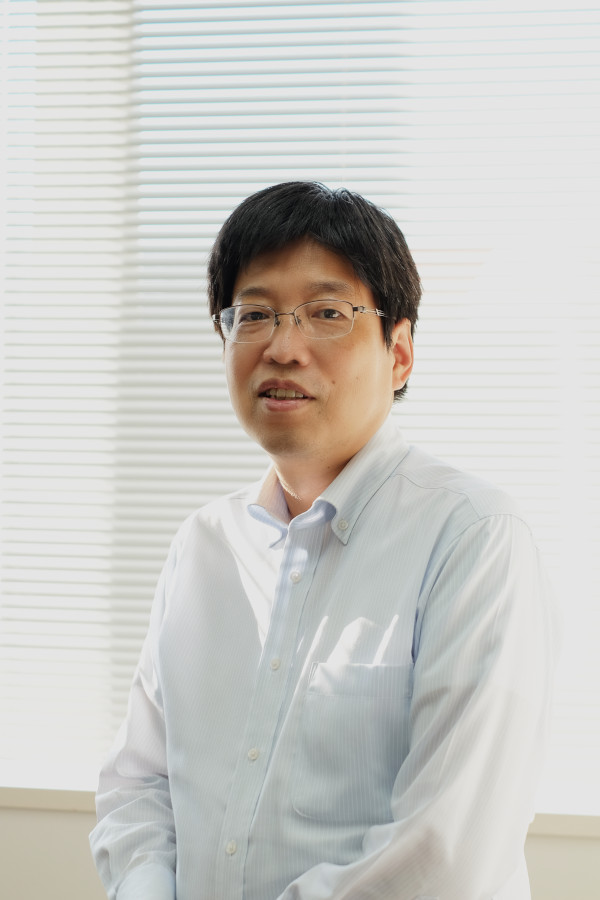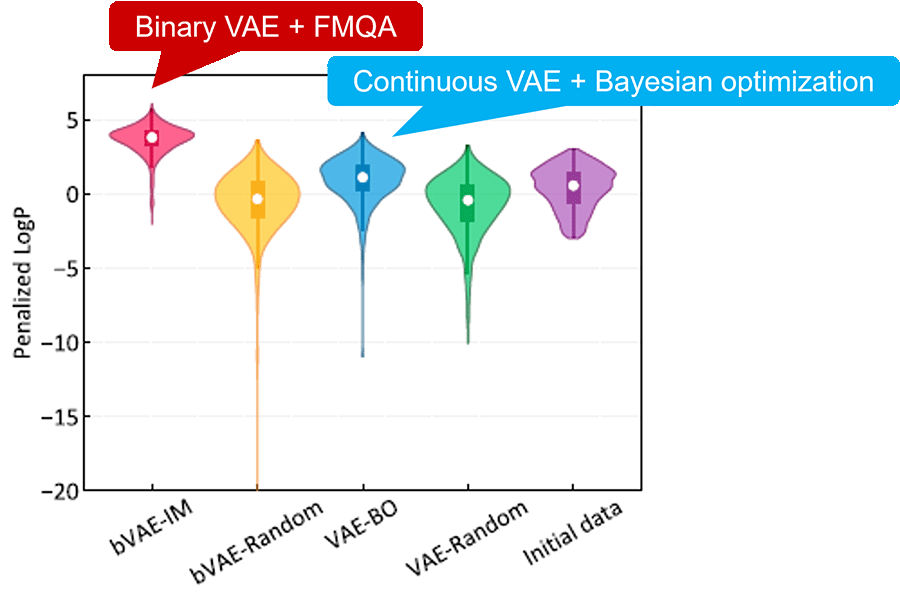Prof. Tsuda's laboratory is engaged in research on the theories and applications of Materials Informatics
(MI), and in 2020 they proposed a black-box optimization method, named FMQA, combining machine learning and
quantum annealing. FMQA has attracted a great deal of attention from various fields because it is applicable
not only to the field of material development, but also to a wide range of fields, such as material search in
chemical and pharmaceutical industries, and design optimization in the manufacturing industry (e.g., airfoil
shape). We interviewed members of Prof. Tsuda's Laboratory about how FMQA was developed and behind-the-scenes
stories.
Interview Topics
-
Stories behind the development of FMQA
-
The Concept of 'Outsourcing Optimization'
What are the research areas that Prof. Tsuda's laboratory is working on and what is
FMQA?
Prof. TsudaOur laboratory conducts theoretical research in machine
learning, data mining, and statistical science, as well as applied research in a wide range of fields,
including molecular biology, protein science, organic chemistry, and materials science.
FMQA refers to a type of black-box optimization with discrete variables that combines
machine
learning, called Factorization Machines (FM), with optimization by Quantum Annealing Ising machines
(QA). Black-box optimization is a method of searching for the optimal input to obtain a desired
output for a system where only the inputs and outputs can be observed, and the internal phenomena are too
complex to model explicitly. In black-box optimization, the optimal solution is found through repeated
experiments and simulations while utilizing machine learning, Bayesian optimization, etc. FMQA makes
it possible to search for good solutions efficiently and reduces the required number of experiments and
simulations.
Dr. KitaiIn 2020, we published a paper on FMQA and its application to the
design of a metamaterial with a tailored thermal radiation spectrum. By using FMQA, we successfully
designed structures with unprecedented radiative cooling performance, demonstrating that FMQA has good
optimization performance. At that time, we used D-Wave's quantum annealing machine for the QA part.
 Prof. Tsuda (Professor, Department of Computational Biology and Medical
Sciences, Graduate School of Frontier Sciences, The University of Tokyo)
Prof. Tsuda (Professor, Department of Computational Biology and Medical
Sciences, Graduate School of Frontier Sciences, The University of Tokyo)
Dr. TamuraIn 2023, we took on the challenge of automatic design of molecular
structures and showed that a method that combines discrete VAE (Variational Autoencoder) and FMQA can design
molecular structures with better performance than the conventional method that combines continuous VAE and
Bayesian optimization. In this research, we used Fixstars Amplify, for the QA part, and I would like to thank
Dr. Matsuda, CTO of Fixstars Amplify Corporation, for his cooperation in preparing the manuscript.
 Conceptual diagram of FMQA
Conceptual diagram of FMQA
 Performance comparison of molecules designed by discrete VAE + FMQA and
those designed by conventional methods
Performance comparison of molecules designed by discrete VAE + FMQA and
those designed by conventional methods
Please tell us about the background and how FMQA was developed. I heard that the
development of FMQA was greatly influenced by Prof.Tsuda's intuitive inspiration and encounters with people.
Dr. TamuraI originally came from a physics background and did research on Ising
models when I was a student. In 2012, I joined the National Institute for Materials Science (NIMS), where my
research interests shifted to materials and chemistries, and in 2017, I had the good fortune to become a
lecturer at Prof. Tsuda's laboratory.
I remember that it was around 2018 when Prof. Tsuda suddenly said in a conversation, "I
think quantum
annealing (Ising model) can be used for black-box optimization.
In 2017, D-Wave's 2000Q quantum annealing machine was released, and it was around this time that the word
"quantum annealing" was gradually being heard around the world. At that time, we were having a difficult time
trying to formulate second-order problems that would take advantage of the quantum annealing machines, so I
remember being very surprised when I heard that quantum annealing could be used for black-box optimization,
which would not require explicit formulation.
Prof. Tsuda
At the time, "quantum computers" were beginning to attract attention, and I was personally very interested in
this field and wondered if I could somehow utilize it in my own research. It was not that I had something
definitive in mind, but I had an intuitive feeling that black-box optimization was one of the places to use
quantum annealing. I knew that Dr. Tamura had been working on Ising models and quantum annealing, so I talked
to him.
Dr. Tamura
I was skeptical right after the conversation, but when I solved regression problems as black-box optimization
problems using a quantum annealing machine, I was very surprised that it worked better than I had expected.
After that, through repeated trial and error, including Dr. Kitai, we realized that if we
used FM, which
uses second-order terms among decision variables, to estimate the model, the estimated model coefficients
could be used as QUBO coefficients as they are, and the combinatorial optimization problems could be solved
in a straightforward manner. This realization led to a rapid progress in our research.
In fact, in our research for the paper published in 2020, we completed the design of the algorithm before
finding the application of the design of the metamaterials. As I worked with Prof. Tsuda on this research, I
was greatly impressed that this might be how something new is born.
I see, so Prof. Tsuda's intuitive inspiration and having the right partner nearby with
the necessary knowledge had a big influence on the development of FMQA. How did you come to use Fixstars
Amplify?
Dr. TamuraI have been serving as a Project Manager (PM) for the "Mitou Target
Program” (IPA, Information-technology Promotion Agency, Japan) since 2018, and I was acquainted with the
current CTO of Fixstars Amplify Corporation, Dr. Matsuda, who was also a PM of the program. Also, as Fixstars
Amplify has been adopted and utilized in the Mitou Target Program since 2021, I heard the reputation from
the students and selected applicants who had used Fixstars Amplify in the program that Fixstars Amplify SDK
was very easy to use and that Fixstars Amplify AE, a GPU-based Ising machine, had a good performance.
When we started this research on black-box optimization, we used D-Wave's quantum annealing machine because of
the "quantum" motivation. However, as we advanced our research, we started to desire to try to solve larger
problems using FMQA, which led us to start using Fixstars Amplify, which had a good reputation.
The fact that we could easily compare the performance of the different machines, and the
fact that it
was free for research and development use in academia was also appealing.
How was your experience with Fixstars Amplify?
Dr. KitaiThere is extensive documentation and sample codes
on the
Fixstars Amplify website, and by referring to them, I could start using it without difficulty. I also
find it very easy to use, as it has a range of helper functions such as one-hot, and automatic machine
settings.
Dr. TamuraSince more than half of the members of Prof. Tsuda's laboratory are
postdoctoral fellows and doctoral students from other countries, we often communicate in English. The
Fixstars Amplify website has extensive English documentation and sample codes, which have been very helpful in
that regard as well.
Did you encounter any difficulties in this research?
Prof. TsudaIn the early days of the research, there were many times when I
found that the program was working but not producing the desired results. Because FM is a machine learning
model, there were some difficulties in the investigations to identify why things didn't work well.
However, as we continued our research, we noticed a strange phenomenon: in black-box optimization, even if the
prediction accuracy of model estimation (the FM part) is high, the final solution obtained is not necessarily
good. Normally, it would seem that the higher the prediction accuracy of the model estimation, the better the
final solution, but empirically, this does not necessarily seem to be the case. Although the theoretical
clarification for this has not yet been established, it may be that FM is a very simple model
that is well suited for searching with the Ising machines.
What are your expectations for Fixstars Amplify in the future?
Prof. TsudaIn black-box optimization, the task of “optimization”, searching for
the optimal solution using an acquisition function estimated from the data, is quite difficult in practice.
It’s not that it’s difficult theoretically, it’s difficult as it requires comparing and examining various
methods, such as genetic algorithm, Bayesian optimization, and optimization utilizing Ising machines, and
adjusting parameters to effectively utilize each method. It’s a difficult task, especially for those who are
not experts on optimization.
Since we would like to devote our maximum time to the research for materials, rather than
for
optimization, we feel that some kind of standardization of optimization methods would be of great
help. For example, we hope to see "outsourced optimization," in which our
application
researchers perform the conversion to the QUBO problem, and then subsequently perform the optimization by
selecting the most appropriate method from various methods developed by optimization experts. We believe that
this will give us, the application researchers, more time to concentrate on the more important parts of
the research. As I understand that Fixstars Amplify Corporation is driving its business based on a vision of
making cutting-edge technologies accessible to all, I look forward to seeing the great future, such as
“outsourced optimization”, to come with the contributions of Fixstars Amplify.
Finally, what are your future plans for research?
Prof. TsudaCurrently, we are conducting research on FMQA which deals with
continuous variables, and FMQA which deals with multi-objective optimization. We also plan to conduct research
on third-order and fourth-order FMQA in addition to second-order FMQA in the future. Through these studies, we
hope to show that FMQA can be applied to more complex and difficult problems, and we hope to see that FMQA
will widely be used more in MI and non-MI areas.
* All information in this article is based on information available at the time of the interview
(July 2023).
After the interview
We interviewed Prof. Tsuda, Dr. Tamura, and Dr. Kitai, the "developer" of FMQA, which has been
attracting attention in recent years as one way to utilize quantum annealing Ising machines.
We hope that you can feel the dynamism of the moment when a new research field is born through this
interview.
His suggestion that it is important not to pursue too much accuracy in FM, but to balance the entire
black-box optimization process, was very helpful in practice. We provide various R&D support using FMQA
to customers in a variety of industries. Please feel free to contact us if you have any questions.
Click here to fill out the inquiry form.
Demos of FMQA and black-box optimization are available here.
Interviewer: Yoshiki Matsuda (President & CEO, Fixstars Amplify Corporation)